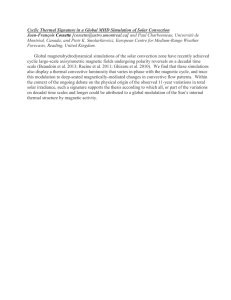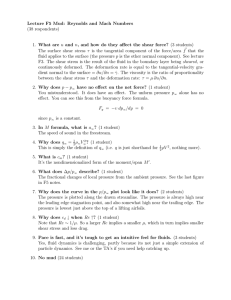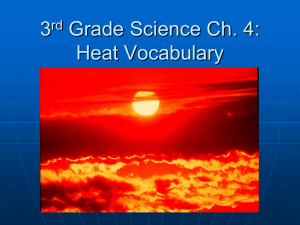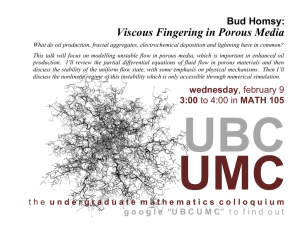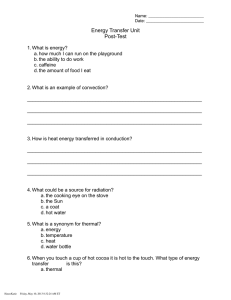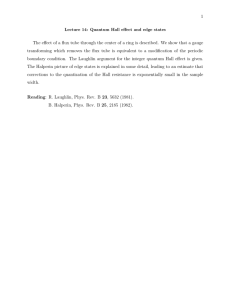Nonlinear thermal convection in a layer of nanofluid under G-jitter and internal heating effects
advertisement
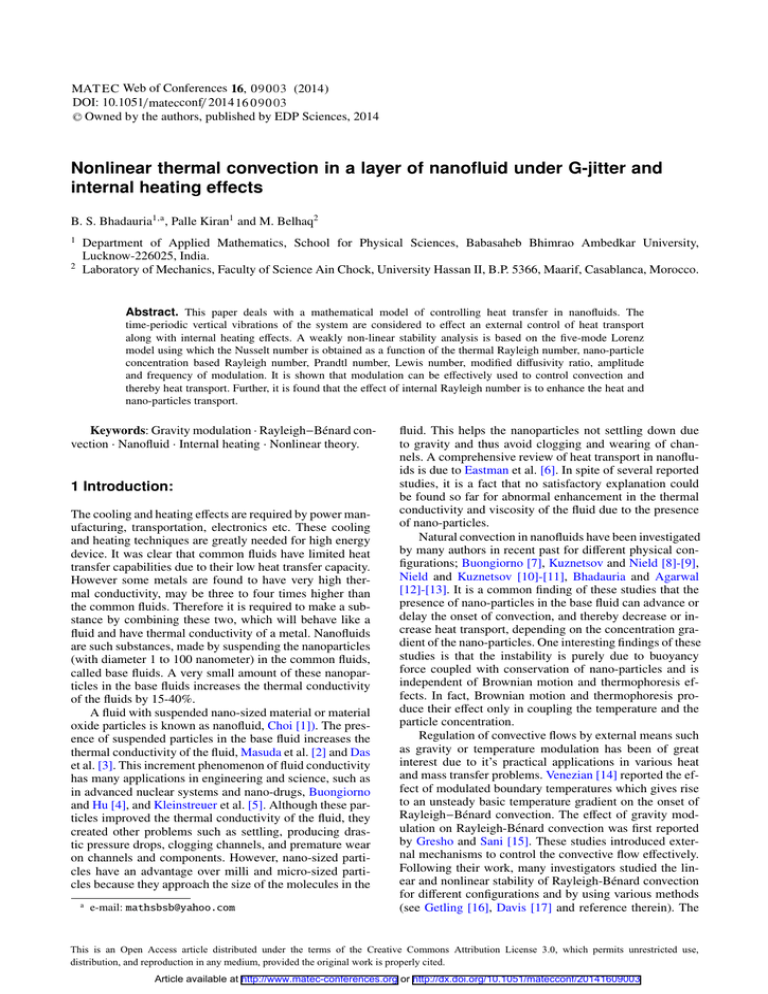
MAT EC Web of Conferences 16, 0 9 0 0 3 (2014)
DOI: 10.1051/matecconf/ 201 4 16 0 9 0 03
C Owned by the authors, published by EDP Sciences, 2014
Nonlinear thermal convection in a layer of nanofluid under G-jitter and
internal heating effects
B. S. Bhadauria1,a , Palle Kiran1 and M. Belhaq2
1
2
Department of Applied Mathematics, School for Physical Sciences, Babasaheb Bhimrao Ambedkar University,
Lucknow-226025, India.
Laboratory of Mechanics, Faculty of Science Ain Chock, University Hassan II, B.P. 5366, Maarif, Casablanca, Morocco.
Abstract. This paper deals with a mathematical model of controlling heat transfer in nanofluids. The
time-periodic vertical vibrations of the system are considered to effect an external control of heat transport
along with internal heating effects. A weakly non-linear stability analysis is based on the five-mode Lorenz
model using which the Nusselt number is obtained as a function of the thermal Rayleigh number, nano-particle
concentration based Rayleigh number, Prandtl number, Lewis number, modified diffusivity ratio, amplitude
and frequency of modulation. It is shown that modulation can be effectively used to control convection and
thereby heat transport. Further, it is found that the effect of internal Rayleigh number is to enhance the heat and
nano-particles transport.
Keywords: Gravity modulation · Rayleigh−Bénard convection · Nanofluid · Internal heating · Nonlinear theory.
1 Introduction:
The cooling and heating effects are required by power manufacturing, transportation, electronics etc. These cooling
and heating techniques are greatly needed for high energy
device. It was clear that common fluids have limited heat
transfer capabilities due to their low heat transfer capacity.
However some metals are found to have very high thermal conductivity, may be three to four times higher than
the common fluids. Therefore it is required to make a substance by combining these two, which will behave like a
fluid and have thermal conductivity of a metal. Nanofluids
are such substances, made by suspending the nanoparticles
(with diameter 1 to 100 nanometer) in the common fluids,
called base fluids. A very small amount of these nanoparticles in the base fluids increases the thermal conductivity
of the fluids by 15-40%.
A fluid with suspended nano-sized material or material
oxide particles is known as nanofluid, Choi [1]). The presence of suspended particles in the base fluid increases the
thermal conductivity of the fluid, Masuda et al. [2] and Das
et al. [3]. This increment phenomenon of fluid conductivity
has many applications in engineering and science, such as
in advanced nuclear systems and nano-drugs, Buongiorno
and Hu [4], and Kleinstreuer et al. [5]. Although these particles improved the thermal conductivity of the fluid, they
created other problems such as settling, producing drastic pressure drops, clogging channels, and premature wear
on channels and components. However, nano-sized particles have an advantage over milli and micro-sized particles because they approach the size of the molecules in the
a
e-mail: mathsbsb@yahoo.com
fluid. This helps the nanoparticles not settling down due
to gravity and thus avoid clogging and wearing of channels. A comprehensive review of heat transport in nanofluids is due to Eastman et al. [6]. In spite of several reported
studies, it is a fact that no satisfactory explanation could
be found so far for abnormal enhancement in the thermal
conductivity and viscosity of the fluid due to the presence
of nano-particles.
Natural convection in nanofluids have been investigated
by many authors in recent past for different physical configurations; Buongiorno [7], Kuznetsov and Nield [8]-[9],
Nield and Kuznetsov [10]-[11], Bhadauria and Agarwal
[12]-[13]. It is a common finding of these studies that the
presence of nano-particles in the base fluid can advance or
delay the onset of convection, and thereby decrease or increase heat transport, depending on the concentration gradient of the nano-particles. One interesting findings of these
studies is that the instability is purely due to buoyancy
force coupled with conservation of nano-particles and is
independent of Brownian motion and thermophoresis effects. In fact, Brownian motion and thermophoresis produce their effect only in coupling the temperature and the
particle concentration.
Regulation of convective flows by external means such
as gravity or temperature modulation has been of great
interest due to it’s practical applications in various heat
and mass transfer problems. Venezian [14] reported the effect of modulated boundary temperatures which gives rise
to an unsteady basic temperature gradient on the onset of
Rayleigh−Bénard convection. The effect of gravity modulation on Rayleigh-Bénard convection was first reported
by Gresho and Sani [15]. These studies introduced external mechanisms to control the convective flow effectively.
Following their work, many investigators studied the linear and nonlinear stability of Rayleigh-Bénard convection
for different configurations and by using various methods
(see Getling [16], Davis [17] and reference therein). The
This is an Open Access article distributed under the terms of the Creative Commons Attribution License 3.0, which permits unrestricted use,
distribution, and reproduction in any medium, provided the original work is properly cited.
Article available at http://www.matec-conferences.org or http://dx.doi.org/10.1051/matecconf/20141609003
MATEC Web of Conferences
the variables that are defined in the above equations are
given in Nomenclature. Assuming temperature and volumetric fraction of the nanoparticles to be constant at the
stress-free boundaries, we may take the boundary conditions on T and φ as:
v = 0, T = T h , φ = φ0 at z = 0,
v = 0, T = T c , φ = φ1 at z = d,
effect of temperature modulation on nanofluid convection
in porous medium has been reported recently by Umavathi
[18] by performing a linear stability analysis.
It appears that all of the above studies deal with the
case of uniform heating from below, and the case of internal heating has been largely neglected. There is one paper that deals with an internal heating problem and that
is Royer and Flores [19]. This involved a numeral treatment of convection in a two-dimensional box. The case of
a homogeneous porous medium with uniform volumetric
heating was first studied by Gasser and Kazimi [20] and
Nield and Bejan [21]. The literature on internal heating is
much less extensive than that on external heating. Some
latest studies are due to Bhadauria et al. [22], Bhadauria
[23] and Bhadauria et al. ([24],[25],[26]).
There is no study available which concern the effect of
g-jitter and internal heating Rayleigh−Bénard convection
in nanofluids. This motivates us to do the present study
by performing a weakly nonlinear analysis under gravity
modulation and internal heating effects.
2 Governing Equations
We consider a layer of nanofluid, confined between two
horizontal boundaries, respectively at z=0 and z=d, heated
from below and cooled from above. The fluid layer is extended infinitely in x and y-directions, and z-axis is taken
vertically upward with the origin at the lower boundary. T h
and T c are the temperatures at the lower and upper walls
respectively such that T h > T c . The physical configuration of the nanofluid layer given in Fig.1. Employing the
Oberbeck-Boussinesq approximation, the governing equations, to study the thermal instability in a nanofluid layer,
are [Buongiorno ([6]):
∇ · v = 0,
∂v
+ v · ∇v + ∇p = μ∇2 v
∂τ
+[φρ p + (1 − φ){ρ f (1 − β(T − T c ))}]g
(ρc) p
∂T
[DB ∇φ · ∇T
+ v · ∇T = κT ∇2 T +
∂τ
(ρc) f
DT
+
∇T · ∇T ] + Q(T − T c )
Tc
DT 2
∂φ 1
∇T
+ v · ∇φ = DB ∇2 φ +
∂τ Tc
(1)
where φ1 is greater than φ0 . The dimensionless variables
are considered as given below:
(x∗ , y∗ , z∗ ) = (x, y, z)/d, τ∗ = τκT /d2 , (u∗ , v∗ , w∗ ) = (u, v, w)d/κT ,
0
c
and T ∗ = TTh−T
p∗ = pd2 /μκT , φ∗ = φφ−φ
−T c , where κT =
1 −φ0
kf
(ρc) f
. The non-dimensionalized governing equations are (after dropping the asterisk for simplicity)
g = g0 (1 + cos(Ωτ)) k̂
∇·v=0
1 ∂v
+ v · ∇v = −∇p − ∇2 v
Pr ∂τ
−gm (Rm − Ra T + Rnφ) eˆz
∂T
NB
+ v · ∇T = (∇2 + Ri )T +
∇φ · ∇T
∂τ
Le
NA N B
+
∇T · ∇T
Le
NA 2
∂φ
1 2
+ v · ∇φ =
∇ φ+
∇T
∂τ
Le
Le
(10)
(11)
(12)
T = 0, φ = 1 at z = 1,
(13)
Lewis number Le = DkTB .
Modified diffusivity ratio
h −T c )
NA = DDBTT(T
c (φ1 −φ0 )
Modified particle-density increment
ε(ρc) p (φ1 −φ0 )
NB =
(ρc) f
Thermal Rayleigh-Darcy number
h −T c )
Ra = ρg0 βKd(T
μkT
Basic density Rayleigh number
[ρ φ +ρ(1−φ )]g Kd
Rm = p 0 μkT 0 0
Concentration Rayleigh number
(ρ −ρ)(φ −φ )g Kd
Rn = p μk1 T 0 0 . At the basic state, the nanofluid is
assumed to be at rest, therefore the quantities at the basic
state will vary only in z-direction, and are given by:
(14)
Substituting Eq.(14) in Eq.(10) and Eq.(11), we get:
d2 T b
NB dφb dT b NA NB dT b 2
+ Ri T b +
+
(
) = 0.
Le dz dz
Le
dz
dz2
(4)
(9)
v = 0, T = 1, φ = 0 at z = 0, and v = 0,
v = 0, p = pb (z), T = T b (z), φ = φb (z).
(3)
(8)
where gm = (1 + cos(Ωt)). The non-dimensionlized parameters in the above equations are; NA is the modified
diffusivity ratio, which is similar to the Soret parameter
that arises in cross diffusion in thermal instability. Prandtl
number Pr = ρ f μkT
ρ
(2)
(6)
(7)
(15)
Using an order of magnitude analysis, Kuznetsov and Nield
([27]), Tzou ([28]-[29]) showed that the second and third
terms in equation Eq.(15) are small and hence we have:
(5)
09003-p.2
d 2 φb
d2 T b
+ Ri T b = 0,
= 0.
2
dz
dz2
(16)
CSNDD 2014
dB02 (τ) πα
=
A11 (τ)B11 (τ) − (4π2 − Ri )B02 (τ)
dτ
2
8π2 Ri
A11 (τ) (31)
+ 4
9π − 10π2 Ri − R2i
dC11 (τ)
1
= −[αA11 (τ) + δ2C11 (τ) + παA11 (τ)
dτ
Le
NA 2
C02 (τ) +
δ B11 (τ)] (32)
Le
dC02 (τ) πα
4π2
=
A11 (τ)C11 (τ) −
[C02 (τ)
dτ
2
Le
+NA B02 (τ)]. (33)
The boundary conditions for solving Eq.(16) can be obtained from Eq.(13) as:
T b = 1, φb = 0 at z = 0, T b = 0, φb = 1 at z = 1.
(17)
Solving Eq.(16), subject to the above conditions (17) and
(17), we obtain:
√
sin Ri (1 − z)
Tb =
, φb = z.
(18)
√
sin Ri
3 Stability Analysis
We now superimpose perturbations on the basic state as
given below:
v = v , p = pb + p , T = T b + T , φ = φb + φ .
(19)
Substituting the above expression (19) in Eqs.(8)-(11), and
using the expressions (18) and (18), eliminating the pressure and introducing the stream function, we obtain:
1 ∂(ψ, ∇2 ψ)
1 ∂ 2
(∇ ψ) − ∇4 ψ =
Pr ∂τ
Pr ∂(x, z)
∂φ
∂T
+(Rn
− Ra )gm k
∂x
∂x
∂T b ∂ψ
∂T ∂(ψ, T )
2
−
− (∇ + Ri )T = −
+
∂z ∂x
∂τ
∂(x, z)
∂ψ NA 2
1 2
∂φ ∂(ψ, φ)
−
−
∇T=
∇ φ−
+
∂x Le
Le
∂τ ∂(x, z)
(20)
(21)
(22)
The above system of simultaneous autonomous ordinary
differential equations can be subsequently solved numerically using Mathematic NDSolve, subjected to the chosen
suitable initial conditions.
4 Heat and Nanoparticle Concentration
Transport
The thermal Nusselt number, Nu(τ) is defined as
⎤
⎡ 2π/α
⎥
⎢⎢⎢ c ∂T
dx ⎥⎥⎥⎥⎥
⎢⎢⎢⎢
∂z
⎥⎥⎥
⎢ 0
⎥⎥⎥
Nu(τ) = 1 + ⎢⎢⎢⎢⎢
⎥⎥⎥
⎢⎢⎢ 2π/α
c ∂T b
⎢⎣
dx ⎥⎥⎦
∂z
0
z=0
Substituting equations (18) and (27) in Eq.(34), we get
Nu(τ) = 1 − 2πB02 (τ)
A local nonlinear stability analysis shall be performed and
hence we will take the following Fourier expressions:
ψ=
T=
φ=
∞
∞ Amn (τ) sin(mαx) sin(nπz)
(23)
Bmn (τ) cos(mαx) sin(nπz)
(24)
Cmn (τ) cos(mαx) sin(nπz).
(25)
n=1 m=1
∞ ∞
n=1 m=1
∞ ∞
n=1 m=1
We consider modes (1, 1) for stream function, and (0, 2)
and (1, 1) for temperature and nanoparticle concentration:
ψ = A11 (τ) sin(αx) sin(πz)
T = B11 (τ) cos(αx) sin(πz) + B02 (τ) sin(2πz)
φ = C11 (τ) cos(αx) sin(πz) + C02 (τ) sin(2πz),
(26)
(27)
(28)
where the amplitudes A11 (τ), B11 (τ), B02 (τ), C11 (τ) and C02 (τ)
are functions of time and are to be determined. Substituting equations (26) - (28) in equations (20) - (22) taking the
orthogonality condition with the eigenfunctions associated
with the considered minimal mode, we get:
dA11 (τ) Pr
= 2 {α (1 + cos(Ωt)) [RnC11 (τ)
dτ
δ
−RaB11 (τ)] − δ4 A11 (τ)} (29)
dB11 (τ)
4π2 a
A11 (τ) + δ2 B11 (τ)
= −{ 2
dτ
(4π − Ri )
−Ri B11 (τ) + παA11 (τ)B02 (τ)} (30)
(34)
(35)
The nanoparticle concentration Nusselt number, Nuφ (τ) is
defined similar to the thermal Nusselt number. Following
the procedure adopted for arriving at Nu(τ), one can obtain
the expression for Nuφ (τ) in the form:
Nuφ (τ) = (1 − 2πC02 (τ)) + NA (1 − 2πB02 (τ)).
(36)
5 Results and Discussion
The nanofluids have an enhanced magnitude of
thermal conductivity than normal fluids or metals, being
attributed to the presence of nanoparticles in them. Here,
we have investigated the effect of gravity modulation in a
horizontal fluid layer saturated by a nanofluid with internal
heating effect. Using Brinkman model and considering top
heavy fluid layer, we performed a weakly nonlinear stability analysis to study the heat transport. It is well known
that, we make a nonlinear theory to analyze heat transport,
which is not possible by linear stability theory. Moreover
external regulations of convection is important in the study
of thermal instability, therefore, in this paper we have considered gravity modulation for either enhancing or inhibiting the convective heat transport as is required by a real life
application. Here note that according to Buongiorno ([7]),
for most nanofluids investigated so far Le is large, but as
per Bhaduria and Agarwal ([13]) and Umavathi ([18]), we
have considered Le = 10 in the case of nanopartical concentration Rayleigh number. The values of Ri are considered to be moderate so that it will not affect the effect of
09003-p.3
MATEC Web of Conferences
gravity modulation of the system by dominating it otherwise. The effect of gravity modulation on heat transport
has been depicted in Figs.2-14. The following parameters
Ri , Pr, Rn, NA , Le, and Ω occurring in the present study,
influence the convective heat transport. The first five parameters are related to the nanofluid and the next two parameters concern the external mechanism of controlling
convection. Because of small amplitude of modulation, the
values of are considered to be small. Further, the gravity modulation assumed to be of low frequency, as at low
range of frequencies, the effect of frequency on onset of
convection as well as on heat transport is maximum. The
coefficient of heat transport, i.e. thermal Nusselt number
and the coefficient of nanoparticle concentration transport,
i.e. concentration Nusselt number are calculated as functions of time and other parameters of the system. The obtained results are depicted in the Figs. 2-14 for Nu(τ) and
Nuφ (τ) verses time τ. In the figures, the values of Nu(τ)
and Nuφ (τ) start with 1 and 2 respectively, and remains
constant for a quite some time, showing the conduction
state. Then the values of Nu(τ) and Nuφ (τ) increase as time
passes, thus showing that the convection is taking place.
These values oscillate and then approach constant values
thus showing that the steady state of the system has been
achieved.
4.0
3.5
Nu
1.5
1.0
0.0
0.1
0.2
0.3
Τ
0.4
0.5
0.6
Fig2.Nu vns Τ for different values of Ri
8
NuΦ
7
6 Ri 1,2
5
4
3
2
0.0
0.2
0.4
0.6
Τ
0.8
1.0
1.2
Fig3.NuΦ vns Τ for different values of Ri
3.5
Pr0.9,1.0
Nu
3.0
2.5
2.0
1.5
1.0
0.0
0.1
0.2
0.3
Τ
0.4
0.5
0.6
Fig4.Nu vns Τ for different values of Pr
8
NuΦ
7
6
Pr0.9,1.0
5
4
3
2
0.0
Fig. 8 shows that, NA and Le do not have significant
effect on the thermal Nusselt number as reported earlier
by Bhadauria and Agarwal ([12]). On the contrary in the
case of concentration Nusselt number both Le and NA have
increasing effect given in the Figs. 9 and 10 and so the heat
and concentration transport.
Figs. 13 and 14 show that the effect of increasing frequency of gravity modulation on heat and nanoparticle concentration transport is to decrease the values of Nu and
Nuφ , and hence stabilize the system. Thus, we obtain the
classical results as per Gresho and Sani ([15]).
2.5
2.0
We fix the values of parameters as Ri = 1.0, Pr =
1.0, Rn = 10.0, NA = 1.0, Le = 10.0, = 0.1 and Ω = 2.0
and drawn the graphs by varying individual values of each
parameter. From the Figs.2 and 3, we observe that the effect of internal heating on thermal instability is destabilizing, as heat transport increases on increasing Ri . The
heat transport is more at higher values of Ri . This confirms the results obtained most recently by Bhadauria [23]
and Bhadauria et al. ([24]-[25]-[26]). ‘ From the Figs. 4
and 5, we find that initially when time τ is small the vibrations become of high amplitudes as the value of Pr increases, and so Nusselt and concentration Nusselt numbers
increase, thus increasing the rate of heat and nanoparticle
concentration transport. But at large values of time τ, the
vibrations become smaller and subsequently the values of
Nu and Nuφ approach steady state values. The influence of
concentration Rayleigh number Rn on both thermal Nusselt number as well as on concentration Nusselt number is
found to be similar that is to enhance the heat and concentration transport as given in Figs. 6 and 7, which is due to
the fact that the nanoparticle concentration is more at the
top.
Figs. 11 and 12 show that the effect of increase in the
amplitude of gravity modulation on heat and nanoparticle
concentration transport is to increase the values of Nu and
Nuφ , and hence transport phenomena in both the cases.
Ri 1,2
3.0
0.2
0.4
0.6
Τ
0.8
1.0
1.2
Fig5.Nu Φ vns Τ for different values of Pr
It is observed in most of the cases that there is much effect of parameters on Nu and Nuφ at low values of time, but
less effect at large time, since vibrations become smaller in
magnitude, and disappears as Nu, Nuφ reach steady state
value.
Finally, the parameters Pr, Rn, have destabilizing effects on the system, while Ω has stabilizing effect. The parameters NA , Le does not show any effect on Nu, but increase the value of Nuφ .
09003-p.4
CSNDD 2014
9
3.5
8
Rn90,10,90
2.5
2.0
0.1
0.2
0.3
Τ
0.4
0.5
2
0.0
0.6
Nu
NuΦ
0.6
0.8
Τ
1.0
1.2
3.0
6 Rn90,10,90
5
2.5
4
2.0
3
1.5
Rn90,10,90
2
0.0
0.2
0.4
0.6
Τ
1.0
0.0
0.8
Fig7.NuΦ vns Τ for different values of Rn
3.5
N A 1,2
3.0
Le10,20
Ε0.3,0.2,0.1
0.1
0.3
0.4
Τ
0.5
0.6
8
7
2.5
2.0
6
5
4
1.5
Ε0.3,0.2,0.1
3
0.1
0.2
Fig11.Nu vns Τ for different values of Ε
NuΦ
Nu
0.4
3.5
7
0.2
0.3
Τ
0.4
0.5
2
0.0
0.6
0.2
0.4
Τ
0.6
0.8
1.0
Fig12.NuΦ vns Τ for different values of Ε
Fig8.Nu vns Τ for different values of Le and NA
10
3.5
N A 1.5
3.0
Nu
8
6
N A 1
2.5
2,8,14
2.0
4
2
0.0
0.2
Fig10.Nu Φ vns Τ for different values of Le
8
1.0
0.0
Le10
5
3
Fig6.Nu vns Τ for different values of Rn
NuΦ
6
4
1.5
1.0
0.0
Le15
7
NuΦ
Nu
3.0
1.5
0.2
0.4
0.6
Τ
0.8
1.0
1.0
0.0
1.2
0.1
0.2
0.3
0.4
Τ
0.5
0.6
Fig13.Nu vns Τ for different values of Ω Fig9. Nu Φ vns Τ for different
6 Conclusions
8
NuΦ
7
We have investigated weakly nonlinear stability of a
vertically vibrating horizontal nanofluid layer with internal heating effect, which is heated from below and cooled
from above. Further, we incorporate the effect of Brownian motion along with thermophoresis. The top heavy suspension of nano particles has been considered. The results
have been obtained in terms of the concentration and thermal Nusselt numbers with the help of the finite amplitude
6
5
4
3
2
0.0
2,8,14
0.2
0.4
Τ
0.6
0.8
1.0
Fg14.NuΦ vns Τ for different values of 09003-p.5
MATEC Web of Conferences
equation. The effect of various parameters have been obtained and depicted graphically. We have the following observations:
1. Gravity modulation can be used to regulate the heat
transport effectively.
2. The effect of internal heating is to increase the heat
transport in the system.
3. Increment in concentration Rayleigh number Rn, modified diffusivity ratio NA and Lewis number Le increase
the effect of gravity modulation.
4. An increment in Pr is to increase the values of Nu(τ)
and Nuφ (τ) at small values of time τ but no effect at
large time τ.
5. The effect of increased nanoparticle concentration Rn
is to enhance the heat and concentration transport.
6. There is no significant effect of NA and Le on thermal
Nusselt number.
7. Increasing Le, , NA and Rn is to increase the concentration Nusselt number, whereas an increase in Ω decreases the same, and so the concentration transport.
Nomenclature
γ
(ρc)m
(ρc) f
Nanoparticle volume fraction
Kinematic viscosity μ/ρ f
Stream function
Heat capacity ratio
φ
ν
ψ
Subscripts
b
Superscripts
’
Operators
∇2
∇21
Basic solution
Dimensional variable
Perturbation variable
∂2
∂2
∂2
+
+
∂x2 ∂y2 ∂z2
∂2
∂2
+
∂x2 ∂z2
ACKNOWLEDGMENT
This work was done during the lien sanctioned to the author B.S Bhadauria (BSB) by Banaras Hindu University,
Varanasi to work as professor of Mathematics at Department of Applied Mathematics, School for Physical Sciences, Babasaheb Bhimrao Ambedkar central University,
Lucknow, India. The author BSB gratefully acknowledges
the Banaras Hindu University, Varanasi, India for the same.
The author Palle Kiran gratefully acknowledges the financial assistance from Babasaheb Bhimrao Ambedkar University, Lucknow, India as a Ph.D. research fellowship.
References
Latin Symbols
DB
DT
Da
PrD
Q
Ri
d
kT
km
p
g
τ
T
Tc
Th
v
vD
(x∗ , y∗ , z∗ )
Greek symbols
Ω
α
β
δ
μ
μ̄
ρf
ρp
(ρc) f
(ρc)m
(ρc) p
Brownian diffusion coefficient
Thermophoretic diffusion coefficient
μ̄K
Darcy number, Da = 2
μd
Prantdl-Darcy number, PrD = δPr
Da
Is the internal heat source
2
Is the internal Rayleigh number, Ri = Qd
κT
Dimensional layer depth
Effective thermal conductivity
Thermal diffusivity of porous medium
Pressure
Modulated gravity field
Time
Temperature
Temperature at the upper wall
Temperature t the lower wall
Nanofluid velocity
Darcy velocity
Cartesian coordinates
1.
2.
3.
4.
5.
6.
7.
Amplitude of modulation
Frequency of modulation
8.
Horizontal wave number
Proportionality factor
Porosity
9.
Viscosity of the fluid
Effective viscosity of the porous medium
Fluid density
Nanoparticle mass density
10.
Heat capacity of the fluid
Effective heat capacity of the porous medium
Effective heat capacity of nanoparticle material
09003-p.6
S. Choi, “Enhancing thermal conductivity of fluids
with nanoparticles. in:D.A.Siginer, H.P.Wang(Eds.)
Development and applications of non-Newtonian
flows,”ASME. FED., 231/MD, 66, 99−105, (1995).
H. Masuda, A. Ebata, K. Teramae, N. Hishinuma, “Alteration of thermal conductivity and viscosity of liquid by dispersing ultra fine particles Netsu Bussei,”7,
227−233, (1993).
S.K. Das, N. Putra, P. Thiesen, W. Roetzel, “Temperature dependence of thermal conductivity enhancement for Nanofluids,”ASME J. Heat Transfer., 125,
567−574, (2003).
J. Buongiorno, W. Hu, “Nanofluid coolant for advanced nuclear power plants,”Paper. No. 5705, Proceedings. ICAPP’05, Seoul., 15−19, (2005).
C. Kleinstreuer, J. Li, J. Koo, “Microfluidics of
nano-drug delivery,”Int. J. Heat. Mass. Transf., 51,
5590−5597, (2008).
J.A Eastman, S.U.S. Choi, W. Yu, L.J. Thompson, “Thermal Transport in Nanofluids,”Annual. Rev.
Mater. Res., 34, 219−246, (2004).
J. Buongiorno, “Convective transport in nanofluids,”ASME. J. Heat. Transfer., 128, 240−250, (2006).
A.V. Kuznetsov, D.A. Nield, “Thermal instability in
a porous medium layer saturated by a nanofluid:
Brinkman Model,”Transp. Porous. Med., (2009a).
A.V. Kuznetsov, D.A. Nield, “Effect of local thermal
non-equilibrium on the Onset of convection in porous
medium layer saturated by a Nanofluid,”Transp.
Porous. Med., 1242-009-9452-8, (2009b).
D.A. Nield, A.V. Kuznetsov, “Thermal instability in
a porous medium layer saturated by nonofluid,”Int. J.
Heat. Mass. Transfer., 52 5796−5801, (2009).
CSNDD 2014
11. D.A. Nield, A.V. Kuznetsov, “Onset of convection
with internal heating in a weakly heterogeneous
porous medium,”Transp. Porous. Med., 98, 543−552,
(2013).
12. B.S. Bhadauria, S. Agarwal, “Natural convection in
a nanofluid saturated Rotating porous layer: A Nonlinear Study,”Transp. Porous. Med., 87, 585−602,
(2011a).
13. B.S. Bhadauria, S. Agarwal, “Convective transport
in a nanofuid saturated porous layer with thermal
non equilibrium model,”Transp. Porous Med., 88,
107−131 (2011b).
14. G. Venezian, “Effect of modulation on the onset of
thermal convection,”J. Fluid. Mech., 35, 243−254,
(1969).
15. P.M. Gresho, R.L. Sani, “The effects of gravity modulation on the stability of a heated fluid layer,”J. Fluid.
Mech., 40(4), 783−806 (1970).
16. A.V. Getling, “Rayleigh−Bénard Convection: Structures and Dynamics World Scientific,”Singapore,
(1998).
17. S.H. Davis, “The stability of time periodic
flows,”Annu. Rev. Fluid. Mech., 8, 57−74, (1976).
18. J.C. Umavathi, “Effect of thermal modulation on the
onset of convection in a porous medium layer Saturated by a Nanofluid,”Transp. Porous. Medi., 98,
59−79, (2013).
19. J. Royer, L. Flores, “Two-dimensional naturalconvection in an anisotropic and heterogeneous
porous-medium with internal heat-generation”Int. J.
Heat. Mass. Transf., 37, 1387−1399, (1994).
20. R. Gasser, M. Kazimi, “Onset of convection in a
porous-medium with internal heat generation,”J. Heat
Transf. Trans. ASME., 98, 49−54, (1976).
21. D.A. Nield, A. Bejan, “Convection in Porous Media,”4th edn. Springer, New York (2013)
22. B.S. Bhadauria, A. Kumar, J. Kumar, N.C. Sacheti, P. Chandran, “Natural convection in a rotating
anisotropic porous layer with internal heat generation,”Transp. Porous. Med., 90, 687−705, (2011).
23. B.S. Bhadauria, “Double diffusive convection in a
saturated anisotropic porous layer with internal heat
source,”Transp. Porous. Med., 92, 299−320, (2012).
24. B.S. Bhadauria, I. Hashim, P.G. Siddheshwar, “Study
of heat transport in a porous medium under G-jitter
and internal heating effects,”Transp. Porous. Med., 96,
21−37, (2013).
25. B.S. Bhadauria, I. Hashim, P.G. Siddheshwar, “Effect of internal-heating on weakly non-linear stability analysis of Rayleigh−Bénard convection under gjitter,”Int. J. non-linear. Mech., 54, 35−42, (2013).
26. B.S. Bhadauria, I. Hashim, P.G. Siddheshwar, “Effects of time-periodic thermal boundary conditions
and internal heating on heat transport in a porous
medium,”Transp. Porous. Med., 97, 185−200, (2013).
27. A.V. Kuznetsov, D.A. Nield, “Thermal instability in
a porous medium layer saturated by a nanofluid:
Brinkman Model,”Trans. Porous. Med., (2009).
28. D.Y. Tzou, “Instability of nanofluids in natural convection”ASME. J. Heat. Transfer., 130, 072401,
(2008a).
29. D.Y. Tzou, “Thermal instability of nanofluids in
natural convection”Int. J. Heat. Mass. transfer., 51,
09003-p.7
2967−2979, (2008b).

